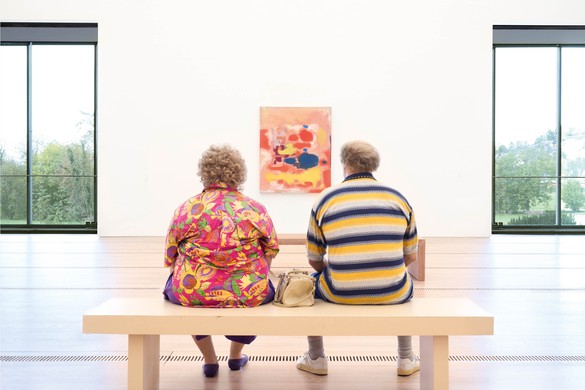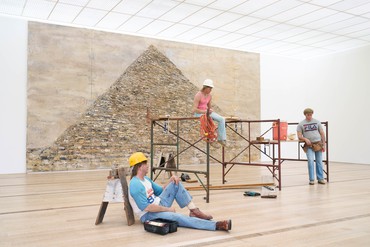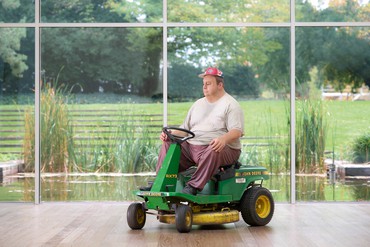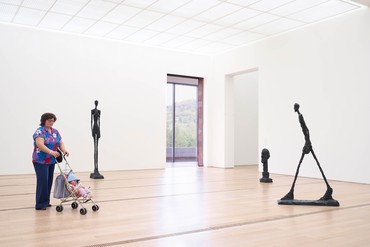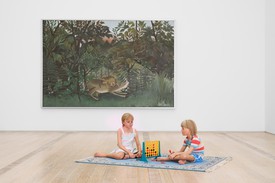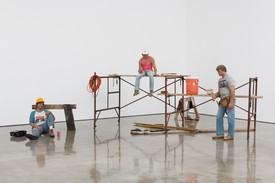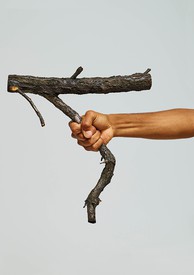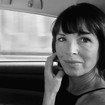
Rachel Cusk is the author of the Outline trilogy (2014–18), the memoirs A Life’s Work (2001) and Aftermath (2012), and several other works of fiction and nonfiction. A Guggenheim fellow, she lives in Paris. Photo: Siemon Scamell-Katz
Why are Duane Hanson’s figures so shocking? How does their pedestrian reality attain such a power of disturbance? Placed beside a Claude Monet or a Mark Rothko, that power is only increased, becomes something against which the morality of art is helpless: the power of indifference. Yet the figures are not exactly indifferent; it is more that they don’t want to be—cannot be—improved. We know this not only because they are finished objects but also because in their human autonomy they question the very notion of improvement by looking at art. It is their double existence, as objects in themselves and as aliens to the concepts of art, that is disturbing. Yet the fact is that they—and by extension we—are also art.
The curious proposition of hyperrealism, whereby assiduous, excessive attention is paid to things that don’t seem—beneath the dubious scrutiny of artistic values—to warrant it, is the reverse of a challenge to aesthetic convention. Its radicality lies in its utter submission to the mechanics of making. The hyperrealist object, by presenting itself as a simulacrum, is exposed not to an artistic or specialized scrutiny but to a universal one: any child could decide whether or not it is convincing. Looking at one of Hanson’s figures, one is instantly overwhelmed, almost embarrassed, by its intimate familiarity. Where usually the experience of looking at art is accompanied by the effort to understand and decode, to penetrate the image and discern the artist’s intentions, here one already knows and recognizes what is being presented. The process of looking is reversed: it is our own intentions that are being scrutinized, for these figures and the existing knowledge they arouse do not elevate us into art-lovers or aesthetes but instead return us to the plane of common humanity, filled with social judgment and division. The figures are more than representations, they are painstaking reproductions of something we generally hold to be unreproducible: human individuality. It would be easier to look at them if they were representational: we would be looking at something the artist was seeing. Instead, it is we who see them and judge them and decide what they are.
The question of attention is central to Hanson’s work, to the extent that his work constitutes a moral question about making and looking at art. An artwork is evidence of an act of attention—the artist’s—which then demands a further act of attention from those who look at it. This secondary attention, the attention of the viewer, presupposes a certain humility, or at least a suspension of judgment in which our own possible ignorance and failure to understand are in play. The image eludes us, is not self-explanatory; our acceptance or rejection of it is not essential to its existence, for it may be that we have no idea what we are looking at. Since the image is indifferent to us, by paying it attention we are entering a state of selflessness that feels like a moral and spiritual improvement on our habitual condition. The hyperrealist reverses this situation by producing a nonelusive work that presents the artist’s attention-state as a form of quotidian labor. The hyperrealist object is, among other things, the evidence of painstaking, repetitive work in which the artist—far from escaping into self-expression—is chained to concrete reality. One of the chief consequences of this reversal applies to the status of the artist himself: he exchanges authorial grandeur for artisanal practicality. This time, initially, it is he, not the viewer, who wears the mantle of humility.
Hanson carries this humility further by his selection of socially and economically marginal subjects who stand adjacent—if not opposed—to the bourgeois values of art. The history of art, like that of literature, is of course filled with such portrayals: what might be called the instinctive elitism of aesthetics strains to incorporate what is other to itself by a process of pure representation. Yet representation can rarely bridge the problem of appropriation of identity, for the artist is essentially a privileged figure who must increasingly produce evidence of shared identity to legitimize their perception of the world. Interestingly, the difference in hyperrealism may lie in the autonomy granted to the hyperrealist object not merely by its material character but by the subjection of the artist to its manufacture. The artist’s instinct for beauty, his privileges not just of interpretation but of a more neutral looking and noticing—noticing light, color, juxtaposition—are absent. His goal lies beyond verisimilitude in an exacting re-creation that is at once pedestrian and godlike.
Re-creation—as with the statues from antiquity that attempted to defy death and loss—is a challenge to mortality. Hanson’s figures do not die; he is not expressing their ephemerality but rather concretizing them in a doubtful eternity. Their actual ephemerality—as in Man on a Mower (1995) or Woman with Child in Stroller (1985)—becomes a kind of curse or bondage: trapped by the material prop or object that delimits their daily existence, they seem marooned in time, forever barred from self-realization. Hanson’s remarks about his practice are gently provocative: the discipline of love, he suggests, is what motivates him to create these laborious memorials to the possibility of meaninglessness. It is a possibility from which we strain to separate ourselves, our presence in an art gallery itself being one way of doing so. Some of Hanson’s people are conspicuously not art-lovers; they are looking away, unaided in the search for meaning. His Old Couple on a Bench (1994) slump vacantly beside one another, their companionship both imprisonment and miracle.
Hanson’s attention—his love—is so vastly in excess of what he presents as his subjects’ (in)significance that it becomes a challenge to the very notion of self-belief. Importantly, it forces us to give them our attention too, and to submit ourselves to what might almost be described as the trauma of empathy. It is not just Hanson’s technique but his power of selection that lays the ground for this process. Why has he chosen these people? What does it mean to be chosen? Our fear that we have not been—will not be—chosen starts to come to light. The deep and structural divisions between ourselves and other humans emerge and gain clarity, then begin to give way to the sense of something shared. How can we share, when we ourselves have to survive? Hanson artfully alludes to hardship and the difficulty of living as plainly besetting his people, but his devotion to them has the effect of increasing our sense of our own pitiable vulnerability and difficulty. What would it mean to receive this devotion ourselves, to be studied and re-created in this way?
Hanson described himself as an outsider and a populist, a disclaimer intended to distance him not just from art’s elitism but from the egotistical basis of perception itself. Self-Portrait with Model (1979) shows him sharing space with one of his creations yet evidently distinct from her: with her self-absorption and her downcast eyes, she seems barely aware of him. He is gazing away, at something we can’t see—like a traveler, someone passing through. His various studies of the forms of workmen, with their tools, their exposed bodies, their paint-spattered or sawn-off clothing, stand in contrast to this gentle, dreaming figure in his clean jeans and shirt. Children Playing Game (1979) (whose models were Hanson’s own offspring) likewise suggests something halfway between innocence and knowledge: the children’s young, unused bodies, bent to a game that is not quite play but rather a sort of preparation for the pointless, repetitive tasks of adulthood, emanate constraint and docility; their dreamy, almost listless expressions seem to query this predicament—life—in which they find themselves. “In the quiet moments in which you observe my work, maybe you will recognize the universality of all people,” Hanson said. Yet the question of violence—the violence of injustice and inequality—is interwoven with this universality to such a degree that we ourselves must begin to take responsibility for it. Are we oppressors or victims? Do we identify with the fleshy, slack American on his mower or with the Monet painting, with its leap toward the sublime, installed behind him?
High School Student (1990)—Hanson’s portrait of his son, Duane Jr.—suggests something more complex, for here the artist’s subjectivity itself is in play. Tentative rather than marginal, the young man seems to stand at the threshold of something: his future, which perhaps he is attempting to steer by means of the book in his hand, or the obligation to live itself, which he seems in his young adulthood to be on the brink of intuiting. There is a special sadness—a pity—in this portrait that perhaps arises from the artist’s actual fathering of its model: knowing the difficulty of living, we yet engender new beings, new fates. The portrait of Duane Jr. also raises the question of time in Hanson’s work: while his other figures attain an immortal ephemerality, here we seem also to see a labor of memory, the tragic knowledge of love. Seeing is different from knowing: while Hanson’s oeuvre might constitute an attempt to minimize that difference, our capacity for universality will always be hampered by the particularity of love. The special pathos of the portrait of Duane Jr. lies in the work’s admission that the autonomy and separateness of the body mark love’s limit; it is the task—or the curse—of memory to amass knowledge around this limit. By binding his figures to a moment in time, while giving radical measures of his own time to re-create that moment, Hanson is trying to break down the loneliness of autonomy. This is the reverse of the photograph or snapshot, the footprint left in the vacated instant. In photography it is the moment, not the individual, that survives. The survival of Hanson’s figures is intimately connected to the share of his own mortality that he has accorded them.
To return to the question of shock: it is the special function of art to confront habits of perception and to demolish the illusions that steadily amass and obstruct truth in the human regard of the world. The hyperrealist project goes farther in removing or radicalizing the space around the art object, with its possibilities for comfort and privilege. The human regard is forced into a more direct meeting—a clash—with the object. In his early work, Hanson interpreted this clash as an opportunity for bare shock by representing scenes of quotidian violence (a motorcycle crash, a war scene, police aggression). Yet his move into social portraiture and a greater subtlety is more shocking still: the offer of art, which is an offer of improvement and elevation, is given a rare ambiguity in these works, to the extent that it is the notion of art itself that becomes shocking. The elements of extremity in American normality that Hanson found in his Floridian landscape are not presented to us in the style of a freak show; they are merely examples of the process of perceptual rejection by which individual consciousness sustains itself. It isn’t difficult to find the equivalent process in any societal milieu, and it is generally only hindsight or history that reveals to us the extent of subjective blindness that experience entails.
The notion that art itself could be incorporated into subjectivity, that its shocks could become gratuitous or artificial, is always open to interrogation. To question what is seen and not seen constitutes the raw edge of any artistic practice. In hyperrealism, the reliance is on making seeing unavoidable, by removing the veil of interpretation and presenting what is already known and recognized to be real. Hanson makes of this both a philosophical occasion and an opportunity for intimate contact between artist and viewer. It is this intimacy, which extends to an intimacy with the object itself, that is so surprising. It is Hanson’s nonviolent method of teaching us to shock ourselves.
Photos: Lucia Hunziker/LLH Productions
